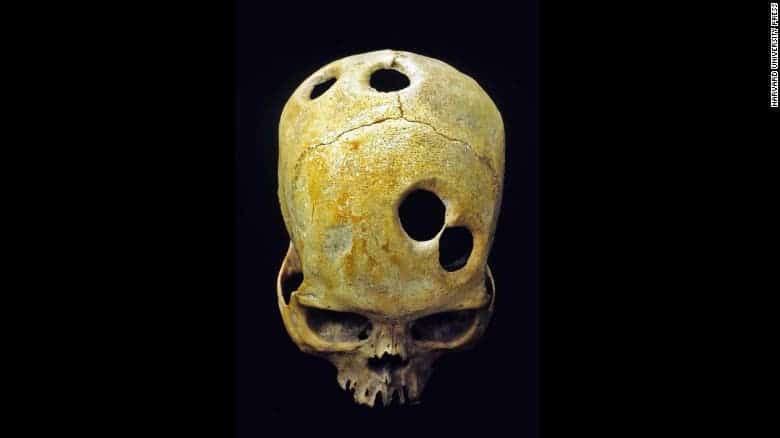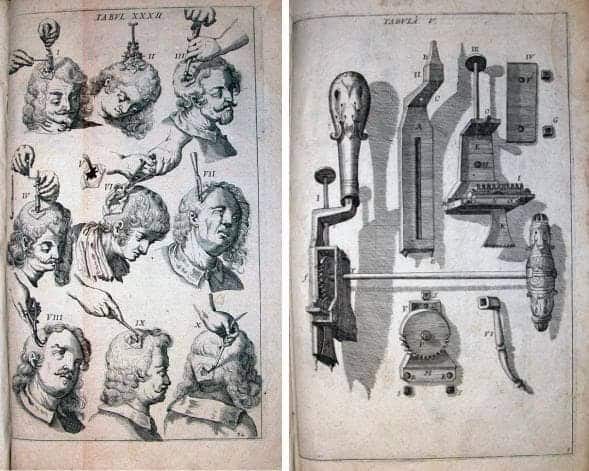
Thousands of years ago medicine wasn’t an exact science anywhere in the world. Let’s just say that practitioners were experimentally heavily and all sorts of creative therapies emerged, euphemistically speaking.
Ancient Egyptians used to prescribe things like lizard blood, dead mice, mud and moldy bread; for women with an impaired libido dosing them with horse saliva would have done the job, so they thought. To treat bad teeth, the Romans would regularly brush their teeth with ammonia-rich urine.
One of the oddest therapies in the medical history books — if it ever was intended as a therapy — has to be the case of trepanned Inca skulls with five or more holes surgically made while the ‘patients’ were still alive. The purpose? No one knows.
I’ll have another, sir
The first Inca skulls with more than five holes were discovered more than a century ago by the same expedition that revealed to the world the lost city of Machu Picchu. Forgotten in a Peruvian burial cave, archeologists came across a couple of such skulls laced with surgically grafted holes which were perfectly circular and consistent in size, but also covered with layers of healed bone. Some of these people survived suggesting that the drilling holes in the skull were made for medical purposes, akin to trepanation — the second oldest surgical procedure following circumcision.
While the practice of making a hole in the skull dates to the Stone Age, the Greek father of medicine Hippocrates was among the first “serious doctors” to endorse it in his book On Injuries of the Head.
An instrument called a trepan was used to make the hole by grabbing a piece of the skull and pulling it away revealing the open brain. Once the wound healed, the surviving patient was left with a bump for the rest of his days.

Typically, in ancient and medieval days, trepanation was used on patients who were thought to be possessed by bad spirits. By making the hole in the skull, it was thought that it would relieve the mind of pressure. Some scholars, claim, however, that some doctors performed trepanations for what we’d call today “legit” neurosurgery to treat headaches, epilepsy, hydrocephalus and mental disorders.
Expanding consciousness
You’d be surprised to hear that trepanation is still a thing today, although reserved for pseudoscience outlets which follow a movement first sparked in the 1960s by a Dutchman named Bart Hughes. What times those were. Practitioners even have their own organization, called the International Trepanation Advocacy Group which states on its website that “trepanation, making a hole in the skull, restores the pulse pressure to the brain. The arteries and capillaries can expand again, filling with an increased amount of blood and displacing the same volume of water.A significant amount of energy, lost with adulthood, returns.”

Vice even has a report in which it interviews a woman named Amanda Feilding who volunteered for trepanation to expand her consciousness. In 1970, when she was 27, she had made a film of herself drilling a hole in her head. Allegedly, some rock stars saw the movie, started circulating it and eventually the film became a sort of cult sensation. Nevertheless, Feilding or the Countess of Wemyss and March as she’s also known has been trepanning since.
“I am an incredibly cautious, paranoid, fearful person … but I am a sculptor, I can make a hole in my head. I used a flat-bottomed drill,” Feilding told VolteFace.
“The trouble with trepanning is that it sounds mad, but there’s a serious hypothesis underlying how it improves cerebral circulation, which I have been researching with a leading Russian neuroscientist.”
Aspirin drill
While trepanation is the stuff of ridicule today, we certainly have to give ancient doctors credit for trying. Even more so in the Inca Empire where people saw skull bashing on a daily basis.
John Verano, a forensic anthropologist and the foremost expert in Inca drilled skulls for more than two decades, says violence has always been amok in Latin America. He personally analyzed more than 800 skulls with at least one hole in them which also bore clear trauma from sling stones and clubs.
Around 2,400 years ago, or about at the same time with Hippocrates — only across the world — Inca doctors or shamans started to treat all these bashed heads by basically making another hole. They would do it to clean a wound, drain a blood clot or give the brain room to swell. Based on evidence like skulls with healed bone, Verano estimates the survival rate was about 40%.
By the time Spaniards met the Inca, the survival rate had jumped to 80% signaling they actually got pretty good at neurosurgery. Personally, that sounds a bit too much considering survival rates for trepanation in the 1800s seldom reached 10% in the best hospitals of the day. Lucky sampling of skulls, maybe?
Nevertheless, once Spain conquered the Inca Empire skulls with holes inside disappeared. But the mystery of multiple-holed skulls hasn’t.
“I doubt that person was hit five times by a small object and each time they cleaned away a piece of bone, and each time he or she survived,” Verano said for CNN, alluding that those instances when people had time and time again their skulls drilled served a different purpose.
It could be, like in the case of trepanation, that the ancient Inca drilled a lot of holes to increase blood flow to the brain with the aim of making the patient more aware, intelligent — or, like the Countess of Wemyss and March, expand consciousness.

Verano hasn’t found any evidence of any, so he doesn’t buy it. Instead, what he proposes is that the procedure was made to relieve headaches. As mention earlier, head bashing was common and it’s very likely a victim could suffer from severe headaches all his life because of the concussions. An Inca doctor might assume that putting a hole here and there, maybe even strategically based on a some now lost assumptions. “We may never know the answer,” he said.
Recently, Verano wrote a book on the subject called “Holes in the Head,” out now from Harvard University Press.


